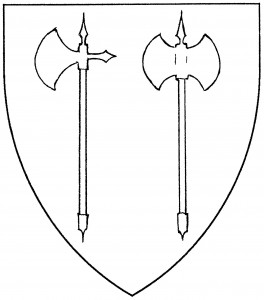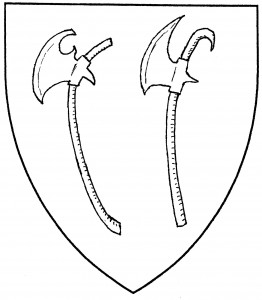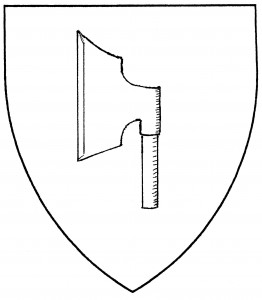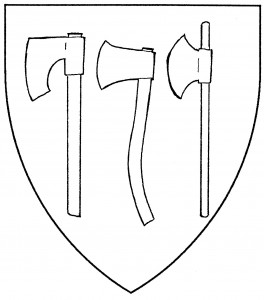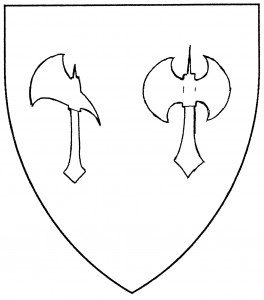An axe is a chopping weapon or tool. It is an ancient charge, found in the arms of the Kings of Denmark as early as 1244 [Asp2 205]. The axe’s default orientation is palewise, with the head to chief and blade to dexter. The haft, when blazoned “proper”, is of brown wood.
There was great variation in the forms of the axe, even for the same coat of arms in period; many strange forms are blazoned simply as an “axe”. No difference is therefore counted between the variants. The most common form is the “battle-axe” or “war-axe”; any axe whose form is unspecified may be safely drawn in this form. The battle-axe is single-bladed by default. The double-bladed form is virtually unknown in period armory – the arms of Maberger, c.1460 [GATD 19v] may be an example, though identification is uncertain – but is quite common in Society armory; this form must be specified in the blazon. A “bearded axe” has an extended cutting edge trailing below the axe-head.
The “Danish axe” and the “Lochaber axe” are similar in form: both have a long, curved haft and broad blade. The Danish axe is found in the arms of the Kings of Norway: de Bara, 1581 [234] explicitly terms it une hache dannoise. By the end of period it was being drawn with a notch in the top of the blade [Siebmacher 2; Woodcock & Robinson, plate 19], which in modern times has become one of its defining features [Parker 29]. The Lochaber axe, as used in Scots heraldry, is similar but defined by a hook at the end [Parker 29]. The distinction between it and the Danish axe, such as it is, is considered simply a guide to the artist; pending period heraldic examples of the Lochaber axe, it is no longer registerable in the Society.
The “broad axe” was fairly common in Continental armory; modern blazons term it a doloire (cooper’s axe), as this form of axe was used for chopping barrel staves. It had a short haft and a wide, smooth blade; the blade is exaggerated in heraldic art. The broad axe is found as early as c.1370, in the arms of Renty [Gelre 48v; also GATD 74, on which the illustration is based]; the English term “brode axe” was used in the grant to the Worshipful Company of Coopers, 1509 [Bromley & Child 56].
The “carpenter’s axe” has a recess behind the cutting edge for the hand to hold and guide the blade. The form is found in period emblazons, such as the arms of von Axt, 1605 [Siebmacher 48]. The term “carpenter’s axe” is the Society’s; the charge is termed a cognée in modern French blazons, but it was unlikely to have been distinguished in period blazons.
Of axe variants unique to Society armory, there are the “hatchet” or “hand-axe”, with a plain head and a proportionally shorter haft; the “francisque”, a hand-axe with an angled head, made for throwing (used mainly for a cant); the “labrys”, a ceremonial double-bladed axe from ancient Crete; the “woodsman’s axe”, also called the “felling axe”, which is fairly plain; and the “headsman’s axe”, also called the “slaughterer’s axe”, also quite plain.
For related charges, see adze, fasces, pick, pole-arm. See also cleaver.
The Thrown Weapons Marshallate bears: Sable, two axes in saltire surmounted by a spear Or.
Sean Ruabarua MacGillaphaidraic bears: Vert, an axe Or.
Sefferey of Wessex bears: Gules, three axes argent.
Richard of the Fens bears: Per chevron vert and Or, six battle-axes counterchanged.
Adelhardt Werner bears: Per pale purpure and Or, a double-bitted axe counterchanged.
James of Prussia bears: Sable, a francisque palewise argent, to the sinister a dagger palewise argent.
Karl vom Acht bears: Gules, a labrys argent bearing two horns issuant from the haft and curving to meet the blades Or.
Dynadan do Pico bears: Quarterly Or and argent, in saltire two headsman’s axes and dependent from the junction a hangman’s noose sable, all within a bordure gules.
Roger Carpenter of Rye bears: Or, in pale a carpenter’s axe reversed and a carpenter’s square, point to base, and on a chief azure three annulets Or.
Michel von Alterstetten bears: Per pale sable and Or, four broadaxes two and two counterchanged.
Thorkell Óláfsson bears: Purpure, on a pile Or a Danish axe gules.
